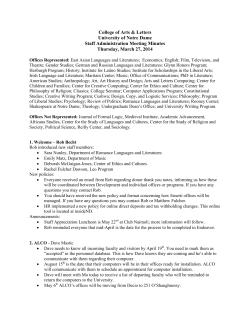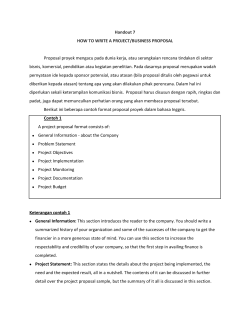
Ania% Murni/Zainal A. Hasibuan (ania%/) RESEARCH METHODOLOGY STUDY PROGRAM: COMPUTER SCIENCE
RESEARCH METHODOLOGY STUDY PROGRAM: COMPUTER SCIENCE COMPUTER SCIENCE FACULTY, UNIVERSITY OF INDONESIA Ania% Murni/Zainal A. Hasibuan (ania%/zhasibua@cs.ui.ac.id) Session Objec%ves • To understand how to search relevant literatures. • To understand the objec%ves of reviewing literatures • To understand the processes of reviewing literatures. • To understand the components of literature to be reviewed. • To understand the state‐of‐the‐art literatures related to the problem statement. Topic in the Mind Map State General Problem Conduct Literature Search State Specific Problem Design Methodology Gather Data Analyze Data Report Results Refine Hypotheses Overview Previous Sessions • The statement of general problem(s) as the basis to find related literatures. – At this state, the nature of the problem(s) s%ll shaky and blurred. • Reviewing literatures will enhance the statement of the problem(s). – Literatures reviewed have to have logical connec%on to the problems statement. • Finding and reviewing related literatures are an art as well a scien%fic acts. What is A Literature Review? (source University Library, University of California) It is a surveys of scholarly articles, books and other sources (e.g. dissertations, journal, conference proceedings) relevant to a particular issue, area of research, or theory Textbook, magazine, Bulletin are not suggested It is providing a description, summary, and critical evaluation of each work (each research article) The purpose is to offer an overview of significant literatures published on a topic (overview the state-of-the-art). Defini%on (Source: Wikipedia).. • A Literature review is a body of text that aims to review the cri%cal points of current knowledge on a par%cular topic. • Most oPen associated with science‐oriented literature, such as a thesis, the literature review usually precedes a research proposal, methodology and results sec%on. • Its ul%mate goal is to bring the reader up to date with current literature on a topic and forms the basis for another goal, such as the jus%fica%on for future research in the area. • A good literature review is characterized by: a logical flow of ideas; current and relevant references with consistent, appropriate referencing style; proper use of terminalogy; and an unbiased and comprehensive view of the previous research on the topic. Defini%on… • According to Cooper (1988) "a literature review uses as its database reports of primary or original scholarship, and does not report new primary scholarship itself. • The primary reports used in the literature may be verbal, but in the vast majority of cases reports are wriZen documents. • The types of scholarship may be empirical, theore%cal, cri%cal/analy%c, or methodological in nature. A literature review seeks to describe, summarize, evaluate, clarify and/or integrate the content of primary reports". How to Find Relevant Literatures? • Search with the key‐word of the resesearch topic. – Use broader key‐word (term) if the documents retrieved are few or none. – Use narrower key‐word if the documents retrieved are too much. – Use synonim or related terms to enhance the search – Employ Boolean operator: AND, OR, NOT to control the search • Pick the most recent and related ar%cle to start with. • Start look for another related ar%cles through: – New search terms found in the related ar%cles – List of references in the chosen ar%cle The Objec%ves of Reviewing Literatures? (source University Library, University of California) • Place each work (research ar%cle) in the context of its contribu%on to the understanding of the subject under review • Describe the rela%onship of each work to the others under considera%on • Iden%fy new ways to interpret, and shed light on any gaps in, previous research • Resolve conflicts amongst seemingly contradictory previous studies • Iden%fy areas of prior scholarship to prevent duplica%on of effort • Point the way forward for further research • Place one's original work (in the case of theses or disserta%ons) in the context of exis%ng literature Why doing a literature review? • • • • • • To iden%fy gaps in the literature To avoid reinven%ng the wheel (at the very least this will save %me and it can stop you from making the same mistakes as others) To iden%fy methods that could be relevant to your project To carry on from where others have already reached (reviewing the field allows you to build on the placorm of exis%ng knowledge and ideas) To iden%fy other people working in the same fields (a researcher network is a valuable resource) To increase your breadth of knowledge of your subject area Cont….Why doing a literature review? • To iden%fy similar works in your area • To provide the intellectual context for your own work, enabling you to posi%on your project rela%ve to other work • To iden%fy opposing views • To put your work into perspec%ve • To demonstrate that you can access previous work in an area • To iden%fy informa%on and ideas that may be relevant to your project Stages of Literature Reviews (source University Library, University of California) • Problem formula%on—which topic or field is being examined and what are issues? • Literature search—finding materials relevant to the subject being explored • Data evalua%on—determining which literature makes a significant contribu%on to the understanding of the topic • Analysis and interpreta%on—discussing the findings and conclusions of per%nent literature Elements of Literature to Review • An overview of the subject, issue or theory under considera%on, along with the objec%ves of the literature review • Division of works under review into categories (e.g. those in support of a par%cular posi%on, those against, and those offering alterna%ve theses en%rely) • Explana%on of how each work is similar to and how it varies from the others • Conclusions as to which pieces are best considered in their argument, are most convincing of their opinions, and make the greatest contribu%on to the understanding and development of their area of research How to Review Literatures? Compare: try to find the similarities among literatures Contrast: try to find the differences among literatures Explain how each article differ to the others Criticize: put your own opinion on what is written in the literatures Explain how each article similar to the others. Criticize the strength and weakness of the research Synthesize: combine several literatures into an idea Summarize: restate the article with your own words in a concise way Examples • Comparing: “Menurut peneli%an yang dilakukan oleh Andri (1999), kinerja IRS dengan menggunakan teknik extended Boolean lebih baik dibanding menggunakan teknik Boolean saja. Hal ini sejalan dengan hasil‐hasil peneli%an sebelumnya yang dilakukan oleh Savoy (1995), Salton (1990), dll.” • Contras%ng: “Hasil peneli%an yang dilakukan oleh Santoso (2006) menunjukkan bahwa gaya belajar konstruk%f lebih adap%f terhadap penggunaan ICT. Hal ini bertentangan dengan hasil peneli%an lainnya yang mengatakan bahwa gaya posi%vist yang lebih adap%f terhadap penggunaan ICT (YYYY, 98; XXXX, 20010”. Examples • Cri%cize: Menurut Hadi (2005) Sistem Informasi Untuk Ekseku%f (EIS) dapat membantu pimpinan mengambil keputusan lebih akurat sekitar 90% dibanding %dak menggunakan EIS, tetapi %dak dijelaskan berapa banyak sample EIS yang disurvei dan kategori keputusan yang bagaimana yang dijadikan sebagai acuan. • Synthesize: Menurut Hadi (2005) keberhasilan suatu Sistem Informasi Untuk Ekseku%f (EIS) sangat ditentukan oleh %ngkat ke akuratan menagkap kebutuhan para ekseku%f sedangkan menurut Amir (2006), EIS sangat ditentukan oleh kejelasan core bisnis dari perusahaannya. Dari kedua pendapat tersebut, dapat dikatakan bahwa faktor‐2 penentu keberhasilan EIS antara lain: keakuratan menangkap kebutuhan pimpinan, dan kejelasan core bisnis perusahaan Where to Place Your Literature Review? • Usually it’s placed at Chapter 2 of your thesis or dissertation • A literature review may constitute an essential chapter of a thesis or dissertation • Literature review should logically connected to research problems, research methodology, analysis and conclusion. Geong Started • • Like many tasks, reading and star%ng to write review literature usually seems worst before you begin So you should make a start 1. First make up an outline—just sit and type points to review 2. Organiza%on. It is encouraging and helpful to start a filing system 3. Timetable. a list of dates for when you will give the first and second draPs 4. Itera%ve. it is easier, however, to improve something that is already wriZen than to produce text from nothing Points to Consider When Reviewing a Literature… (source University Library, University of California) • Provenance—What are the author's creden%als? Are the author's arguments supported by evidence (e.g. primary historical material, case studies, narra%ves, sta%s%cs, recent scien%fic findings)? • Objec%vity—Is the author's perspec%ve even‐handed or prejudicial? Is contrary data considered or is certain per%nent informa%on ignored to prove the author's point? • Persuasiveness—Which of the author's theses are most/least convincing? • Value—Are the author's arguments and conclusions convincing? Does the work ul%mately contribute in any significant way to an understanding of the subject? Points to Discuss in Literature Review: Among others What is the problem and why is it important? Is the problem clearly defined? Try to state the problem as simply as you can Is the research methodology well stated? How’s the data being created and manipulated? Is the manipulated data sufficiently interpreted? What is the contribu%on of the study? Is the conclusion related to the problems? Is the evidence sufficient enough to support conclusion? • Etc. • • • • • • • • • Problem Statement and Background • The first obvious thing which a research should contain is a statement of the problem to be considered, in both specific and general terms. • The specific problem statement must deal with the very specific issues. For example, the op%maliza%on of IT investment related to the maturity of organiza%on. • The general statement should relate the problem to the larger context of the science and show why it is worth solving. For example, IT investment deliver less benefits than expected. Par%al Example of Literature Review The Title of the article Synthesize C r i S u m m a r i z e t i z e C o m p a r e Contrast Benefits of Doing Literature Review To avoid the ambiguity of research problems To ensure the chosen research problems are researchable To depict the “intellectual environment” of the research problems To acknowledge the intellectual social network related to the research problems Example Mosaic of Related Literatures to Research Topic on EGovernment Environment of Organization XYZ IT trend and Organization Respond E-Government Case Study: Organization XYZ Cases of E-Gov Methodology, Method, teknik used for E-Gov Industry, policies, economy IT Penetration IT Organization Exercise • Determine a general research problem • Search literatures related to research problem – Evaluate documents retrieved – Determine relevant documents • Enhance general research problem into several specific research problems (research ques%ons) • Extend the literature search • Form a mosaic of body of literatures related to research topic. TIP If you don’t understand something ask me!
© Copyright 2025
![Slavic Colloq Poster[4] - Division of Literatures, Cultures, and](http://cdn1.abcdocz.com/store/data/001736207_1-952158c37966ee9fda04963713e7f871-250x500.png)

















